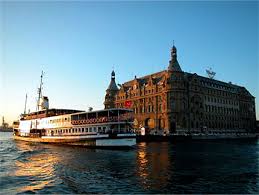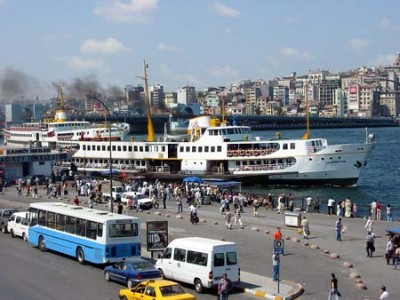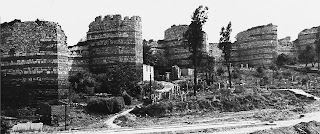CONTINUED FROM ........ 1972 -FROM KARACHI TO ISTANBUL (3)
We woke up early in the morning. My father took me along and we came out of the hotel. The name of the area . which came to know later on, was Kadikoy.
http://www.turkeytravelplanner.com/go/Istanbul/Sights/asia/kadikoy.html
The jetty from where the ferry boats were going to the european side of Istanbul, was not much far from where we were. It was very cold. We had worn, coat and overcoat. I had worn the brown coloured woolen cap too, that could have been extended down to cover the whole face except eyes and nose. I remember it used to be called the monkey cap in those days. Interestingly, my father never wore a cap during his stay in Istanbul.

Well as we came out to the Ferry boat jetty, first of all we got confused about everything. I mean from where to buy the tickets? because we were not too good in counting the local currency. Then from where to enter the waiting lounge, etc. etc.
Well, we managed to board the first ferry boat. It was my first time to board such a boat. The cold wind was almost cutting our faces. The weather was all cloudy, so the sea was quite rough. Almost all of the passengers were sitting inside the sitting hall, but my father was more interested in experiencing the thrill of the moment. So we two were standing in open part of the ferry boat. The wind was hitting us on one hand and on the other the dripplets of uproaring waves were also coming our way. Aloof of all this, my father was too busy in enjoying the Bosphorous view.
After about half an hour we reached the other side of the Bosphorous. We stepped out on the european soil for the first time in our life. It was an important moment of my life. First i had come out of my country, and now i had left Asian continent behind. History was in the making.
The name of the Ferry boat station was EMINONU.

We had already marked everything on our map. We had had to catch a bus to go to Eyup. I was almost lost in the scene around. As compared to the place where i had spent the first 17 years of my life, it was all too different around me. I was trying to adjust myself to the totally changed atmosphere around me. The traffic was totally opposite to what we were used to in Pakistan. The dresses of the people, the skin colours, the voices around us, the scenery, etc etc, everything was grossly different.
Hurriedly we managed to board a bus. I was totally shocked by seeing the discipline at the bus stop. All busses were arrayed in their allotted portions. The boards on the waiting shelters were exhibiting the numbers of the buses for that particular point. The passengers were standing in line, and were boarding the buses one by one. Evey bus was moving on instantly after being full. The next bus in the lane was moving ahead to take in the remaining passengers. There was no shouting, no pushing, no cursing. Everything was going on in a very disciplined and organised way. For me it was a totally different world.
Every bus was having two automatic doors. Everybody was boarding the bus from the back door. The other door remained closed. Nobody was trying to force way inside the bus. The bus conductor, wearing a blue coloured suit, with matching tie, was sitting just by the side of the entrance door. Everybody was paying for the ticket, and moving ahead. It was a scene i had never witnessed before in my life.
Everything was shocking me. I was almost mesmerised.
In the bus some people tried to talk to us, but my father just managed to speak out a few words in turkish. He showed them the address of Erdal Soyulu. They understood that we were asking them to tell us where to get down of the bus. Where there is no language, even then there is a language that people understand. I was witnessing that.
There were no separate compartment for ladies in the bus. Women too were boarding and sitting inside the bus side by side with the men. Interestingly, nobody was pushing or teasing or trying to touch them. I was not used to this in Pakistan. I asked myself, why Turkish men do not touch women , even when they can, and why do Pakistani men like to touch women in public. when they cannot. I could not answer this.
I remember i was too embrassed just thinking about my feelings if a woman would come and sit by side in the bus. Being a Pakistani we could not even think of that. Perhaps this was why i was getting too nervous and excited, just by thinking of some turkish woman sitting by me in the bus, whereas there was no chance for that, because my father was going to sit by my side. There was no third chair.
I noticed that there was a red button just above the front door of the bus. A couple of minutes earlier before arrival of a bus stop, the bus driver used to ask if there was anybody to get down on that particular stop. He used to open the front door only if some passenger was to get down at that bus stop. Otherwise the door used to remain closed. However, there was a small red button above the door, which could be pressed to let the driver know about the passenger wanting to get off the bus.
All doors were opened and closed automatically . by the bus driver.
We got off the bus, at some bus stop, when told by the fellow passengers to get off. It was the area of Eyup.
Once on the road, we tried to ask people on the road to help us. It was drizzling and too cold.
We woke up early in the morning. My father took me along and we came out of the hotel. The name of the area . which came to know later on, was Kadikoy.
http://www.turkeytravelplanner.com/go/Istanbul/Sights/asia/kadikoy.html
The jetty from where the ferry boats were going to the european side of Istanbul, was not much far from where we were. It was very cold. We had worn, coat and overcoat. I had worn the brown coloured woolen cap too, that could have been extended down to cover the whole face except eyes and nose. I remember it used to be called the monkey cap in those days. Interestingly, my father never wore a cap during his stay in Istanbul.
Well as we came out to the Ferry boat jetty, first of all we got confused about everything. I mean from where to buy the tickets? because we were not too good in counting the local currency. Then from where to enter the waiting lounge, etc. etc.
Well, we managed to board the first ferry boat. It was my first time to board such a boat. The cold wind was almost cutting our faces. The weather was all cloudy, so the sea was quite rough. Almost all of the passengers were sitting inside the sitting hall, but my father was more interested in experiencing the thrill of the moment. So we two were standing in open part of the ferry boat. The wind was hitting us on one hand and on the other the dripplets of uproaring waves were also coming our way. Aloof of all this, my father was too busy in enjoying the Bosphorous view.
After about half an hour we reached the other side of the Bosphorous. We stepped out on the european soil for the first time in our life. It was an important moment of my life. First i had come out of my country, and now i had left Asian continent behind. History was in the making.
The name of the Ferry boat station was EMINONU.

We had already marked everything on our map. We had had to catch a bus to go to Eyup. I was almost lost in the scene around. As compared to the place where i had spent the first 17 years of my life, it was all too different around me. I was trying to adjust myself to the totally changed atmosphere around me. The traffic was totally opposite to what we were used to in Pakistan. The dresses of the people, the skin colours, the voices around us, the scenery, etc etc, everything was grossly different.
Hurriedly we managed to board a bus. I was totally shocked by seeing the discipline at the bus stop. All busses were arrayed in their allotted portions. The boards on the waiting shelters were exhibiting the numbers of the buses for that particular point. The passengers were standing in line, and were boarding the buses one by one. Evey bus was moving on instantly after being full. The next bus in the lane was moving ahead to take in the remaining passengers. There was no shouting, no pushing, no cursing. Everything was going on in a very disciplined and organised way. For me it was a totally different world.
Every bus was having two automatic doors. Everybody was boarding the bus from the back door. The other door remained closed. Nobody was trying to force way inside the bus. The bus conductor, wearing a blue coloured suit, with matching tie, was sitting just by the side of the entrance door. Everybody was paying for the ticket, and moving ahead. It was a scene i had never witnessed before in my life.
Everything was shocking me. I was almost mesmerised.
In the bus some people tried to talk to us, but my father just managed to speak out a few words in turkish. He showed them the address of Erdal Soyulu. They understood that we were asking them to tell us where to get down of the bus. Where there is no language, even then there is a language that people understand. I was witnessing that.
There were no separate compartment for ladies in the bus. Women too were boarding and sitting inside the bus side by side with the men. Interestingly, nobody was pushing or teasing or trying to touch them. I was not used to this in Pakistan. I asked myself, why Turkish men do not touch women , even when they can, and why do Pakistani men like to touch women in public. when they cannot. I could not answer this.
I remember i was too embrassed just thinking about my feelings if a woman would come and sit by side in the bus. Being a Pakistani we could not even think of that. Perhaps this was why i was getting too nervous and excited, just by thinking of some turkish woman sitting by me in the bus, whereas there was no chance for that, because my father was going to sit by my side. There was no third chair.
I noticed that there was a red button just above the front door of the bus. A couple of minutes earlier before arrival of a bus stop, the bus driver used to ask if there was anybody to get down on that particular stop. He used to open the front door only if some passenger was to get down at that bus stop. Otherwise the door used to remain closed. However, there was a small red button above the door, which could be pressed to let the driver know about the passenger wanting to get off the bus.
All doors were opened and closed automatically . by the bus driver.
We got off the bus, at some bus stop, when told by the fellow passengers to get off. It was the area of Eyup.
Once on the road, we tried to ask people on the road to help us. It was drizzling and too cold.















































